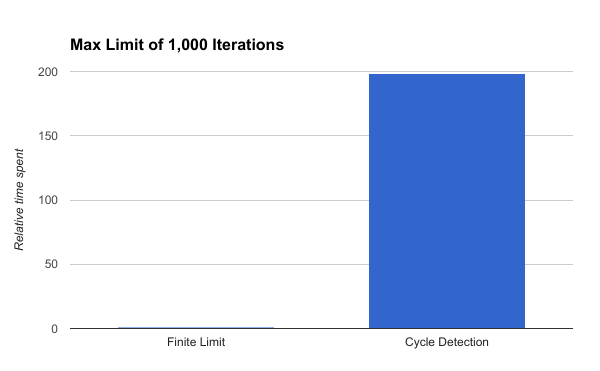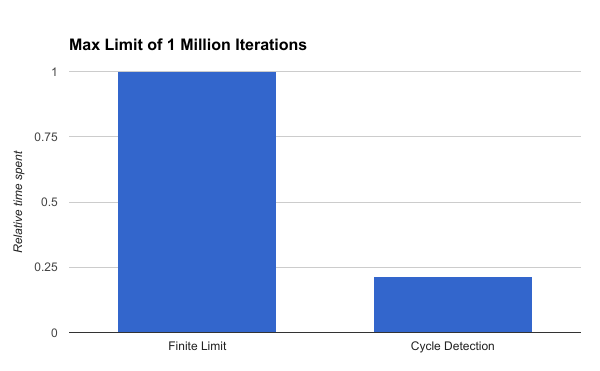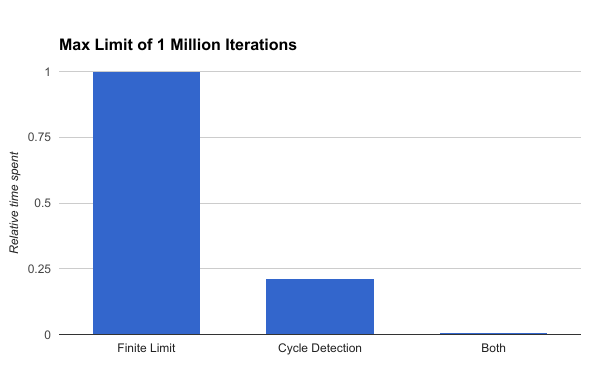In Defense of Brent's Cycle Detection Algorithm
In my earlier series about the Buddhabrot I vilely slandered Brent’s Cycle Detection Algorithm as “kind of a dud.” Well, I’m 99% sure I implemented it wrong the first time I tried it out (oops) so I think it’s time to give it a fairer shot.
I came across the concept of an automatic iteration limit algorithm for finding out whether a point is inside the Mandelbrot set. In this method, there isn’t an explicit maximum iteration count passed in - it will only stop iterating if the point escapes or it detects a cycle. The cycle detection algorithm better work in this case!
Finite Iteration Limit
Here’s a simplfied traditional version of the finding out whether a point is inside the Mandelbrot set:
public bool IsPointInMandelbrotSet(Complex c, int maxLimit)
{
var z = Complex.Zero;
for (int i = 0; i < maxLimit; i++)
{
z = z * z + c;
// check if the point has escaped the circle of radius 2
if (z.Magnitude > 2)
{
return false;
}
}
// Point never escaped, so we think it's in the Mandelbrot set
return true;
}
If we feed this method a complex number inside the set, it will take exactly maxLimit iterations to return.
Automatic Iteration Limit
Let’s see it without the max limit parameter:
public bool IsPointInMandelbrotSet(Complex c)
{
var z = Complex.Zero;
var oldZ = Complex.Zero;
int stepsTaken = 0;
int stepLimit = 2;
int iterations = 0;
while (z.Magnitude <= 2)
{
z = z * z + c;
// z matches an old value, so we found a cycle
if (z == oldZ)
return true;
// Time to update the old value
if (stepsTaken == stepLimit)
{
oldZ = z;
stepsTaken = 0;
stepLimit *= 2;
}
stepsTaken++;
iterations++;
}
// Point escaped, so it's not in the Mandelbrot set
return false;
}
For points inside of the set, it relies entirely on the cycle detection algorithm for knowing when to stop.
When I implemented it the first time, I screwed up when the values were compared (basically, the z == oldZ part was inside the next if statement). I also didn’t use a separate counter for stepsTaken either, which I’m sure screws up the math. In my defense, the pseudo code on Wikipedia is a bit unclear and isn’t exactly the same usecase as this.
Is it fast?
Well, it depends on your max iteration limit and the points you’re feeding it… If you have a really low iteration limit, it might take substantially more iterations to find a cycle than just iterating for a set amount.
Let’s benchmark this. We’ll compute a 25x25 grid of points in a complex area with real bounds of (-1.45, 0.75) and imaginary bounds of (-1.1, 1.1). This will give us a good mix of points outside and inside the set. We’ll leave out threading and geometric checks that can short-circuit the algorithm and plot the relative speed of each method (using the finite limit approach as the baseline; I.E. 1).

Yowza. The cycle detection method is nearly 200x slower!
Let’s see what happens when we bump up the iteration limit to 1 million:

That’s better - the cycle detection is able to bail out of the loop far earlier than 1 million iterations.
Best of Both Worlds?

Of course, there’s nothing preventing us from combining both approaches:
public bool IsPointInMandelbrotSet(Complex c, int maxLimit)
{
var z = Complex.Zero;
var oldZ = Complex.Zero;
int stepsTaken = 0;
int stepLimit = 2;
for (int i = 0; i < maxLimit; i++)
{
z = z * z + c;
if (z.Magnitude > 2)
{
return false;
}
if (z == oldZ)
return true;
if (stepsTaken == stepLimit)
{
oldZ = z;
stepsTaken = 0;
stepLimit *= 2;
}
stepsTaken++;
}
return true;
}
The results are better in both cases:
 (I left out the cycle-detection only method because it was so amazingly bad in this benchmark)
(I left out the cycle-detection only method because it was so amazingly bad in this benchmark)

Conclusion
Well, I think the results speak for themselves. Brent’s Cycle Detection Algorithm is a great thing to use when doing Mandlebrot set calculations, especially once you start getting into massive iteration limits. Its honor has been restored.